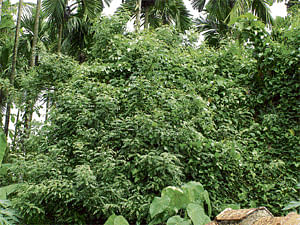

Vani Sharma carefully packs five kilos of brinjal, cucumber and plantain flowers apart from coconuts. These vegetables form the lunch menu for 150-odd children in the Muliya Timmappayya Memorial School, three kilometres away from her house in Bantwal taluk, Dakshina Kannada district.
This is an important part of the routine for Venkatakrishna Sharma and Vani Sharma from the last two years. “We do this voluntarily. There are two advantages; children get fresh vegetables and they develop a taste for native food which is healthier and cheaper,” said Sharma, who is also a board member of the school. “It is not just about developing good food habits among children, it has also fuelled our passion to grow more vegetables in the front yard,” adds Vani. In the last two years, the couple has supplied vegetables to the school every day, free of cost.
They are not large scale vegetable growers. But they make it a point to maintain assorted varieties. Most of the saplings are planted in gunny bags. Around twelve varieties of brinjal, okra, drumstick, tonde, beans, snake gourd, ridge gourd, sweet potato, tapioca, greens and a range of native vegetables are grown in the yard. Though kitchen gardening is a common phenomenon in Sharma’s village, the couple took it up seriously eight years ago. “We were also dependent on vegetables from the market, sometimes it was an easy option.” When they realised the magnitude of pesticides applied to commercially-grown vegetables, they took a decision to start from home.
They also wanted to establish that farmers can be independent of the city’s vegetable markets. Sharma strongly feels that depending on city markets for vegetables of daily need is nothing but dishonouring the importance of native vegetables that are in plenty in the region. “Why can’t we prepare dishes from jackfruit or banana for a wedding ceremony or a puja? During summer every day, there is some sort of celebration in the village. The dishes remain the same. We have shown them that a ceremonial lunch can be tasty without the usual tomato or cabbage.”
Basics of vegetable gardening
The first step was to choose vegetables that can be grown easily and plan for trouble-free maintenance. Brinjal was their first choice. It is a universal vegetable which can be used in any recipe, says Sharma. He lists out the advantages of growing vegetables in the home-yard.
“Monkeys and wild pigs hesitate to come near the house. Since the plants are grown in bags, we can move them easily. Watering also becomes easy.” They two-fold the gunny bags so that the bags don’t wear off until a year. The loose knits allow excess water to drain off. Sharma puts bat droppings along with cow-dung manure to the plants. Around 50 bats have found shelter in his old house which is adjacent to his present house .
The couple are not worried about the pest problem. They believe in natural control. Traditional knowledge of farm labourers is useful in many circumstances. “We have to respect their knowledge gained through experience as well as listen to their problems.”
Many brinjal varieties
Brinjal is a vegetable that has the most number of varieties in their collection, and accounts to seventy-five percent of total production. A variety called gonchalu badane is perennial. The bitter brinjal can very well replace bittergourd. Sharma has been able to collect distinct brinjal varieties over the years.
Meter length, bulb shaped, bottle like; crimson, white, green, maroon, orange coloured brinjals are the attractions of this vegetable garden. The need for providing vegetables everyday to school, has made the Sharma couple try a host of local varieties. If the children approve, then the supply becomes regular.
Nelabasale, an easily grown leafy vegetable is rarely used in the village. Sharma introduced it to the students, who liked its taste. Likewise children are no more reluctant to consume highly nutritious plantain stem and flowers. “Now we like local greens and vegetables more than the ones bought from the city. We also bring home-grown vegetables to the school,” says Avinash who is studying in the tenth standard.
A positive attitude
Sharma represents a farming fraternity that has been quietly sculpting solutions with a positive attitude. Though a traditional areca grower, he has started thinking differently over the last one decade. He is slowly increasing the varieties of intercrops in his conventional areca garden. He is adding wild fruits, flowers and forest species to the established pepper, cocoa, nutmeg, banana and coconut farm.
He has a special plant in his farm, the bannerale (Syzigium hemisphericum) plant. Bats and monkeys love this fruit. “I have only sown the seeds that are thrown by them. We have not got a chance to taste it. But I have multiplied the plant and distributed it to those who ask for it.” His interest in collecting jack fruit varieties has amused farmers in the neighbourhood. During summer, his house is filled with fragrance of sample fruits from far-off farms. His latest venture is to have a one-acre jackfruit grove. He has already collected ten varieties.
When farmers in the region are focusing on rubber plantations for commercial gains, here is a farmer who cares to conserve traditional varieties. “Once we decide to do something we are bound to get support from all the corners.”
Sharma remembers an electrician who brought rare vegetable seeds from his village in North Karnataka. Passion for plant varieties has connected him with different places and people. Having a well-maintained areca plantation, vegetable growing is not a compulsion for the Sharma couple. It is an urge from within. They feel that such habits create a lively network among the like-minded.